When it comes to making the best ribs, the flavor all starts with the dry rub (after sourcing quality protein, of course). If you ever wonder why someone’s ribs taste so much better, it might just be their secret rub. Everyone has their own opinions, but subtly sweet with a little bit of heat kick is what we’re going for, and you will love it too.
Making a homemade dry rub for ribs is so easy. After all, you just combine the ingredients based on the recipe ratios, and it’s totally up to you if you want to customize it to your liking.
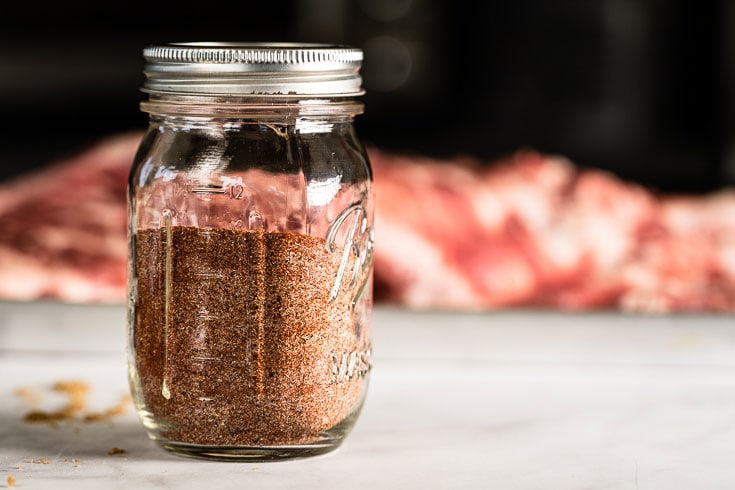
Whether you are cooking your ribs in the smoker, on the grill, in the oven or even sous vide, a dry rub will bring them to the next level.
Not only does this rub add tons of flavor to the ribs, but it helps make that highly sought-after flavorful bark, which when you bite, it makes it all worth it.
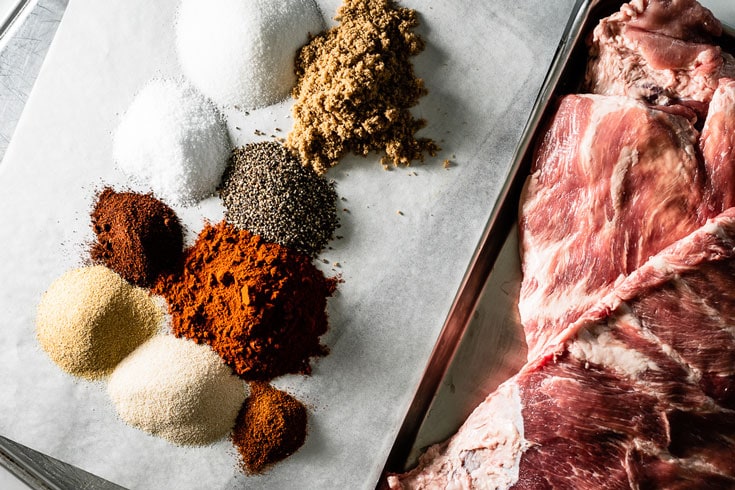
The Ingredients
Pork loves sweet and sweet loves heat. We use a few different types of sugar, some spices for color, some for depth and added flavor, and others for heat.
- Diamond Kosher Salt: If using a different type of salt, you will want to change the ratio. 2 teaspoons Diamond kosher salt = 1 1/2 teaspoons Morton kosher salt = 1 teaspoon table salt.
- Brown sugar: You can use either the light or dark version. It has great flavor from the molasses.
- White sugar: Helps create “bark” during the cook.
- Ground black pepper: Adds that peppery bite and balances against the other flavors.
- Smoked paprika: Can substitute sweet paprika, but I prefer the smoked version for that extra smoky flavor. Paprika also gives color to the ribs.
- Dark chili powder: Adds color and some depth of flavor.
- Garlic powder: For a hint of the garlic flavor.
- Onion powder: Gives the rub a savory depth.
- Cayenne pepper: Most of the heat in the rub comes from the cayenne, so use at your discretion. With only 1 teaspoon in this ratio, it won’t be burning any tongues. Kick it up if you want it hotter.
The Most Basic Rib Rub (Hat Tip to Aaron Franklin)
Now, you could go super simple with a 2:1 ratio of coarse ground black pepper to Diamond kosher salt, which is the Franklin BBQ-style rub that he uses on his ribs. This is a great option for simplicity and really being able to taste the meat and the wonderful smoke, but I’m guessing that you are here for some extra flavor, right? So let’s get to rubbin’!
Salt or No Salt in the Rub?
Salt is really the only thing that penetrates all the way through the meat; none of the other flavors do. It’s just science: The spice molecules aren’t small enough to make it through. For that reason, some people like to keep the salt separate from the other rub ingredients to give you more control. Personally, I usually add it in.
Salt Amount for Ribs: 1/4 teaspoon of Diamond kosher salt per pound.
Use a Slather to Help It Stick
A slather is a binder to help the rub stick to the meat. It could be anything from water to oil to mustard. Do you really need to use a slather? While I almost never find it necessary to use one (the rub sticks just fine), many people still like to use one to get more of the rub on for the long journey.
A Spice Rub Is a Great Gift
Ever think of bringing over a nice Mason jar of your favorite homemade rub to friends? It’s a great gift to add some extra flavor to their meals, and it’s a personal and thoughtful gift that will only cost you a few cents.
Pro Tips for Success
- Use fresh spices. After just a few months, spices can start to lose their potency. You can “bloom” them in a hot skillet for a few minutes to make them even more fragrant.
- Make it your own. Add more spice, less sweet, more savory. Whatever you like, do that.
- Taste it. While it will taste different on your finger or a spoon than it will on the meat, you still want it to taste balanced from the start.
- Know your salt. Sodium levels differ: Diamond Crystal Kosher Salt has 280mg per serving (1/4 teaspoon) compared to Morton’s kosher at 480mg and Morton’s iodized table salt at 590mg. This is primarily due to the differences in coarseness: The coarser the salt, the less salt by weight is in a 1/4 teaspoon. So it’s always important to be familiar with the salt you are using to avoid over or under-seasoning because you followed a recipe that didn’t specify the exact type/brand of salt they used. Learn more in the Salt 101 Guide.
- Sugar can burn. So be careful if cooking over direct heat with a rub that contains sugar. The same goes for a sauce that contains sugar.
- Use smoked salt for an extra smoky flavor. This is great when cooking the ribs in the oven.
- Label the rub container with the date. Rubs can last a few months if kept in a tightly sealed container, but it’s best to use it up in a few weeks for maximum tastiness.
- Write down your recipe with any notes. If you made adjustments, note the result so you remember for next time.
- Keep extra on hand. You can sprinkle on your pork chop, pork roast or chicken wings, or when cooking during the week.
- Save larger 16-ounce spice containers with holes in the lid. They are great for mixing, storing and applying your rubs.
Frequently Asked Questions
You can either apply the rub 15 minutes before smoking, or apply it the night before. There isn’t a massive difference, but applying the rub overnight will act as a dry brine and add some more flavor from the salt and tenderize slightly. If you do go the overnight route, you can add a little more rub on the ribs before smoking.
If your dry rub isn’t sticking, you can use a slather, which can be a drizzle of neutral oil, mustard or even water rubbed on the surface before applying the spice rub.
Use a shaker jar from an elevation of about 12″ to 18″ to get a nice, consistent, even distribution of rub on the meat.
Use about 1/4 cup of rub per rack of ribs. You want a thin even coating, so use your discretion.
Store in an airtight container in a cool, dry place.
Depending on the age of your spices, try to use the rub within a month, but it should last up to 6 months when stored properly. You might need to re-shake/stir if any clumps form when storing.
Related Recipes
- Baked Beans
- Smoked Pork Ribs
- Smoked Sous Vide Ribs
- Smoked Pork Shoulder for Pulled Pork
- Sous Vide Pork Shoulder
- Baby Back Ribs in the Oven
- Smoked Pork Belly
- Pork Dry Rub
- Chicken Dry Rub
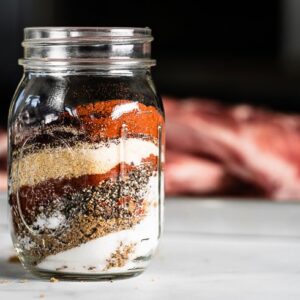
Dry Rub for Ribs
Ingredients
- 2 Tbsp. Diamond kosher salt
- 2 Tbsp. ground black pepper
- 1/4 cup packed brown sugar
- 1/4 cup white sugar
- 1/4 cup smoked paprika
- 1 Tbsp. dark chili powder
- 2 Tbsp. garlic powder
- 2 Tbsp. onion powder
- 1 tsp. cayenne pepper (optional)
Instructions
- Combine all ingredients with a whisk or a fork to break up any clumps.
- Use immediately, or store in a sealed container for up to 6 months.
Notes
- Makes almost one cup dry rub, which is enough for about 4 racks of ribs.
- Store in a sealed container in a cool, dry place away from light.
- It’s best to use the rub within a month, but it can last up to 6 months.
- Label the rub container with the date.

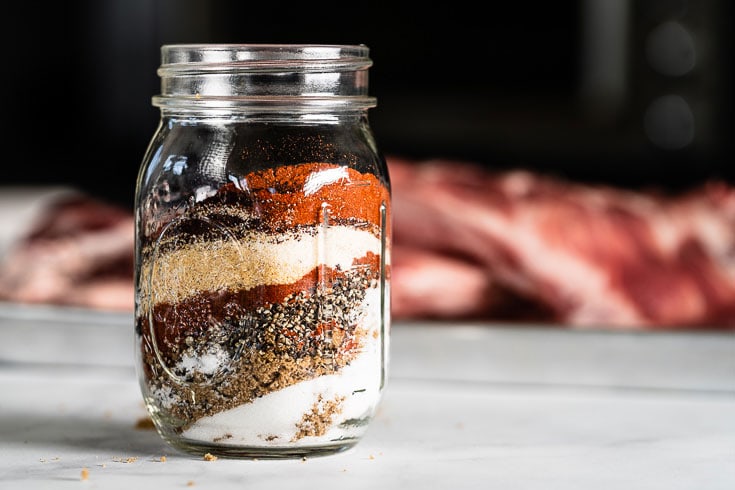
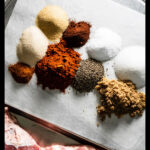
Used this on some baby back ribs that we baked in the oven and the flavor turned out excellent. Also added some to the BBQ sauce that was slathered on.
The pro tips are so great, I did not know that spices loose their potency!!!
So glad you got some good info from them, Mariana!
Yeah, it’s pretty funny with the spices. I would bet that 90% of people’s spice cabinets are past their peak. 🙂